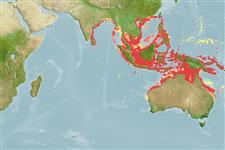>
Eupercaria/misc (Various families in series Eupercaria) >
Lutjanidae (Snappers) > Lutjaninae
Etymology: Lutjanus: Malay, ikan lutjan, name of a fish.
More on author: Richardson.
Environment: milieu / climate zone / depth range / distribution range
Ökologie
seewasser riff-verbunden; tiefenbereich 1 - 80 m (Ref. 9710). Tropical; 23°N - 27°S, 79°E - 159°E (Ref. 55)
Indo-West Pacific: India to northern Australia. Sometimes referred to as Lutjanus chrysotaenia by past authors.
Length at first maturity / Size / Gewicht / Alter
Maturity: Lm 18.6 range ? - ? cm
Max length : 40.0 cm TL Männchen/unbestimmt; (Ref. 55); common length : 30.0 cm TL Männchen/unbestimmt; (Ref. 55); max. veröff. Alter: 20 Jahre (Ref. 37970)
Rückenflossenstacheln (insgesamt): 10; Rückenflossenweichstrahlen (insgesamt): 14-16; Afterflossenstacheln 3; Afterflossenweichstrahlen: 9. Snout somewhat pointed, dorsal profile of head steeply sloped. Preorbital bone about equal to eye diameter, or slightly wider. Preopercular notch and knob poorly developed. Scale rows on back rising obliquely above lateral line. Generally blue-gray on upper side, grading to white or yellow white ventrally with a series of eight or nine or orange or yellow stripes on the sides. The fins are yellowish; the pectoral fins have a distinct black spot at base of uppermost rays and axil.
May be found in turbid coastal waters (Ref. 90102). Adults inhabit coral reefs in both sheltered lagoons and on outer reef slopes. Often encountered in schools of up to 20 to 30 individuals. (Ref. 55)
Multiple spawner.
Allen, G.R., 1985. FAO Species Catalogue. Vol. 6. Snappers of the world. An annotated and illustrated catalogue of lutjanid species known to date. FAO Fish. Synop. 125(6):208 p. Rome: FAO. (Ref. 55)
IUCN Rote Liste Status (Ref. 130435)
Bedrohung für Menschen
Harmless
Nutzung durch Menschen
Fischereien: weniger kommerziell; Sportfisch: ja
Mehr Information
ReferenzenAquakulturAquakultur ProfilZuchtlinienGenetikElectrophoresesVererbbarkeitKrankheitenVerarbeitungNutrientsMass conversion
PartnerBilderStamps, Coins Misc.LauteCiguateraGeschwindigkeitSchwimmstilKiemenoberflächeOtolithsGehirngrößeSehfähigkeit
Tools
Zusatzinformationen
Download XML
Internet Quellen
Estimates based on models
Preferred temperature (Ref.
123201): 25.1 - 29.1, mean 28.2 °C (based on 1340 cells).
Phylogenetic diversity index (Ref.
82804): PD
50 = 0.5000 [Uniqueness, from 0.5 = low to 2.0 = high].
Bayesian length-weight: a=0.01479 (0.00748 - 0.02924), b=2.96 (2.80 - 3.12), in cm total length, based on LWR estimates for this species & Genus-body shape (Ref.
93245).
Trophic level (Ref.
69278): 3.9 ±0.5 se; based on diet studies.
Widerstandsfähigkeit (Ref.
120179): mittel, Verdopplung der Population dauert 1,4 - 4,4 Jahre. (K=0.37-0.45; tmax=20; Fec > 10,000).
Fishing Vulnerability (Ref.
59153): Low to moderate vulnerability (26 of 100).
Nutrients (Ref.
124155): Calcium = 39.8 [23.9, 60.7] mg/100g; Iron = 0.392 [0.255, 0.642] mg/100g; Protein = 18.3 [16.8, 19.6] %; Omega3 = 0.138 [0.093, 0.205] g/100g; Selenium = 59.3 [35.5, 99.9] μg/100g; VitaminA = 224 [44, 920] μg/100g; Zinc = 0.433 [0.332, 0.617] mg/100g (wet weight);
